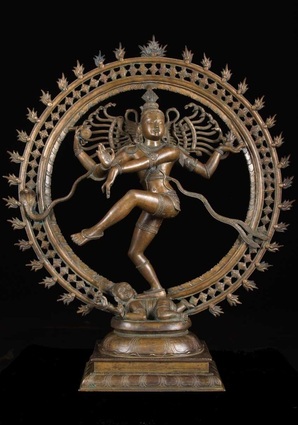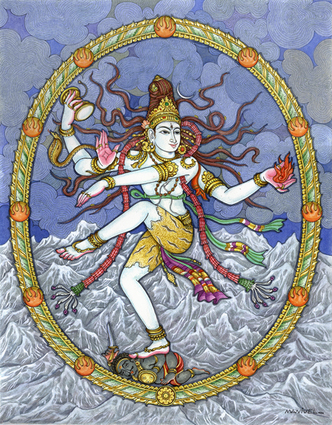| A Brief Introduction to Hinduism |
An Explanation of the Shiva Nataraja, or Dancing Shiva
The Shiva Nataraja is one of Hinduism's oldest forms of art. Many different interpretations of this beautiful design have been made, ranging from small to large. An explanation of the symbolism in the design helps bring to light some Hindu beliefs about Shiva. (All explanations are given relative to the perspective of the observer.)
Hands:
Hands:
- Top Left Hand: This hand holds a small drum, which is said to beat out the rhythm of the universe. Here we see Shiva’s twofold nature: he destroys, but only in order to renew. The drum itself, which is an hourglass shape, represents the union of the divine masculine and feminine aspects. When these two elements are parted, the universe ceases to be.
- Top Right Hand: This hand holds fire. In Hinduism, fire is held to be the element that will destroy the universe. The fact that Shiva can hold the fire in his hand reveals his control over it. In addition, these top two hands taken together represent a balance of creation, in the drum, and destruction, in the fire. This balance illustrates Shiva’s two-part role in destruction.
- Lower Left Hand: This hand makes a gesture called the "abhaya pose," which means “the pose of fearlessness.” While followers of Shiva may be tempted to be afraid of the mighty forces he controls, this sign shows them that Shiva is in control, so they need not fear.
- Lower Right Hand: This hand stretches across Shiva's body, pointing toward his uplifted right leg, showing the way to salvation.
- Right Leg: This leg is uplifted, and points to the left. The fact that the leg is uplifted shows that the way to moksha is through liberation from the material, which is below.
- Left Leg: This leg stands on a demon that represents ignorance. Shiva has defeated this demon, and can show others how to achieve moksha.
- The ring of fire around Shiva represents the universe, but his calm face shows that chaos is not to be feared.
- The snakes that coil and cross around him symbolize three things: power, mastery over temptation, and spiritual awareness. In Hinduism, snakes are said to be the most feared animals. The fact that they surround Shiva and do not disturb him reveals his domination over even the most terrifying aspects of life. Snakes also symbolize temptation, similar to their role in the Biblical story of Eden. Shiva’s dominance of the snakes shows that he has overcome temptation. Another meaning of the snake has to do with spiritual wakefulness. A person's spirituality is visualized as a coiled snake, which uncoils and rises as a person focuses on his or her yoga. The activity of the snakes around Shiva shows his complete spiritual transcendence.
In each Shiva Nataraja, the artist must combine and balance several metaphorical meanings in the appearance of one final work. Each interpretation of the Nataraja form is a compact primer on Shaivism.
Sources:
http://www.exoticindiaart.com/nataraja.htm
http://meditation24-7.com/page54/page54.html
Ramachandran, Vilayanur S. The Tell-Tale Brain. New York: W. W. Norton & Company, Inc., 2011. Print.
Sources:
http://www.exoticindiaart.com/nataraja.htm
http://meditation24-7.com/page54/page54.html
Ramachandran, Vilayanur S. The Tell-Tale Brain. New York: W. W. Norton & Company, Inc., 2011. Print.


